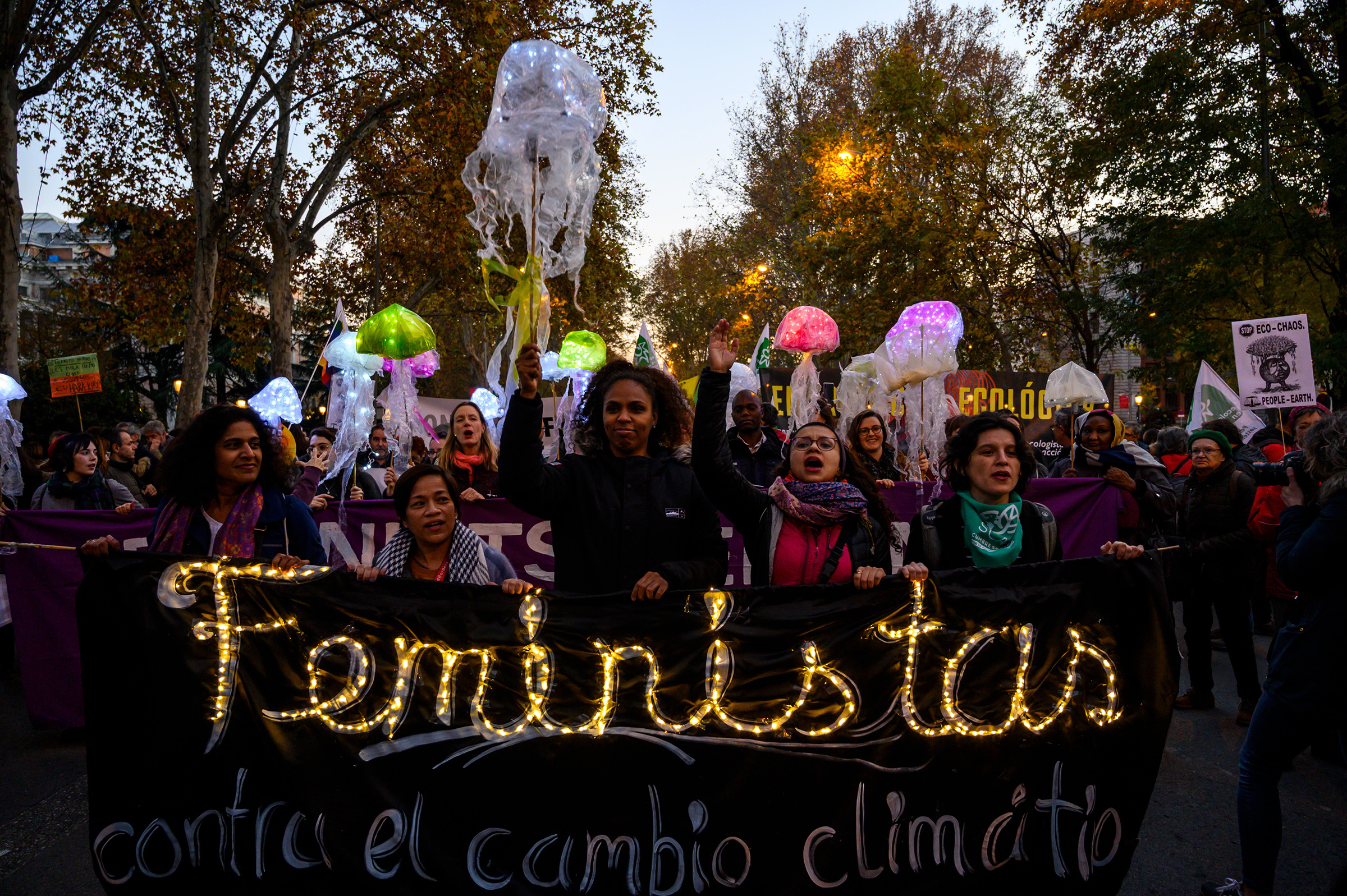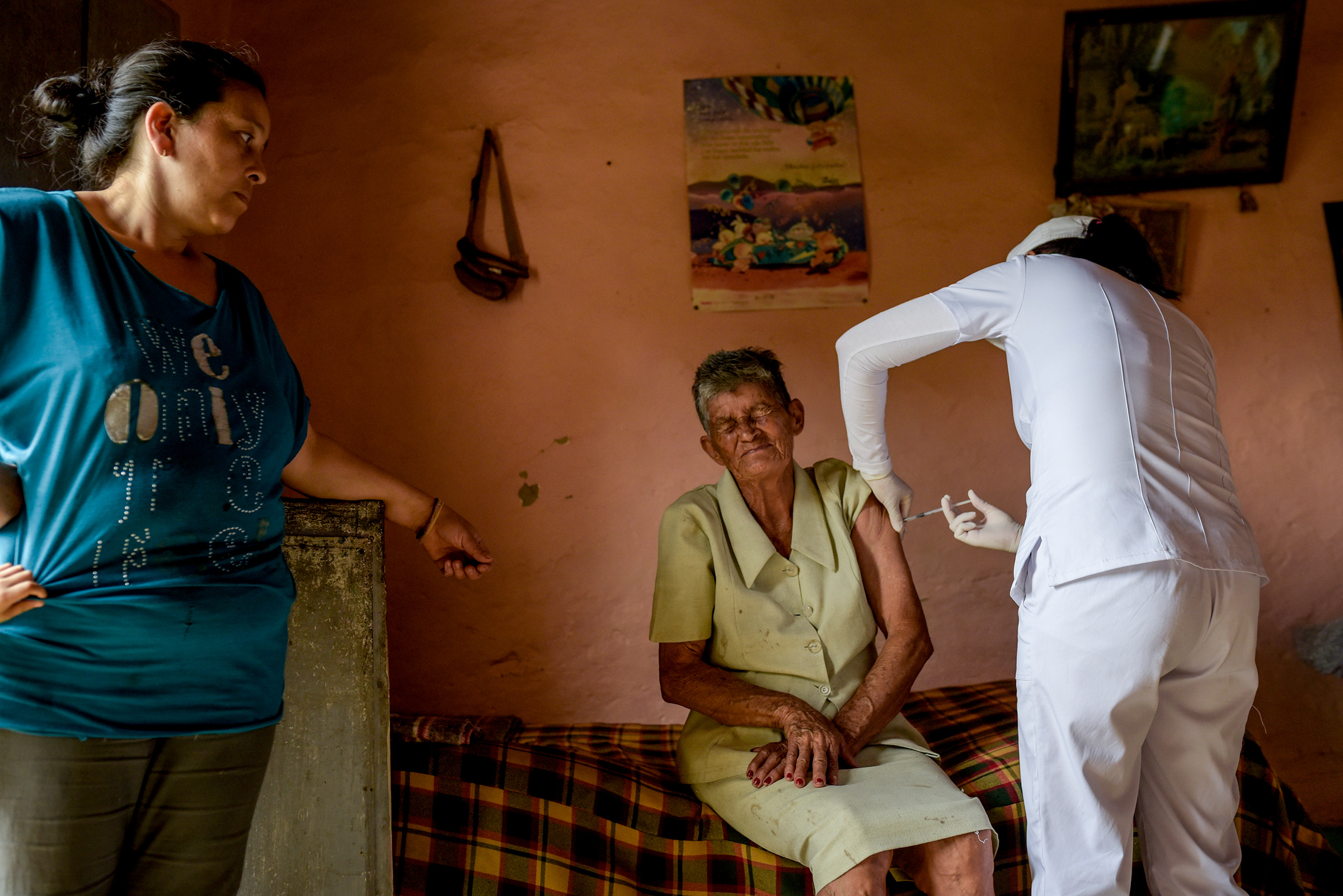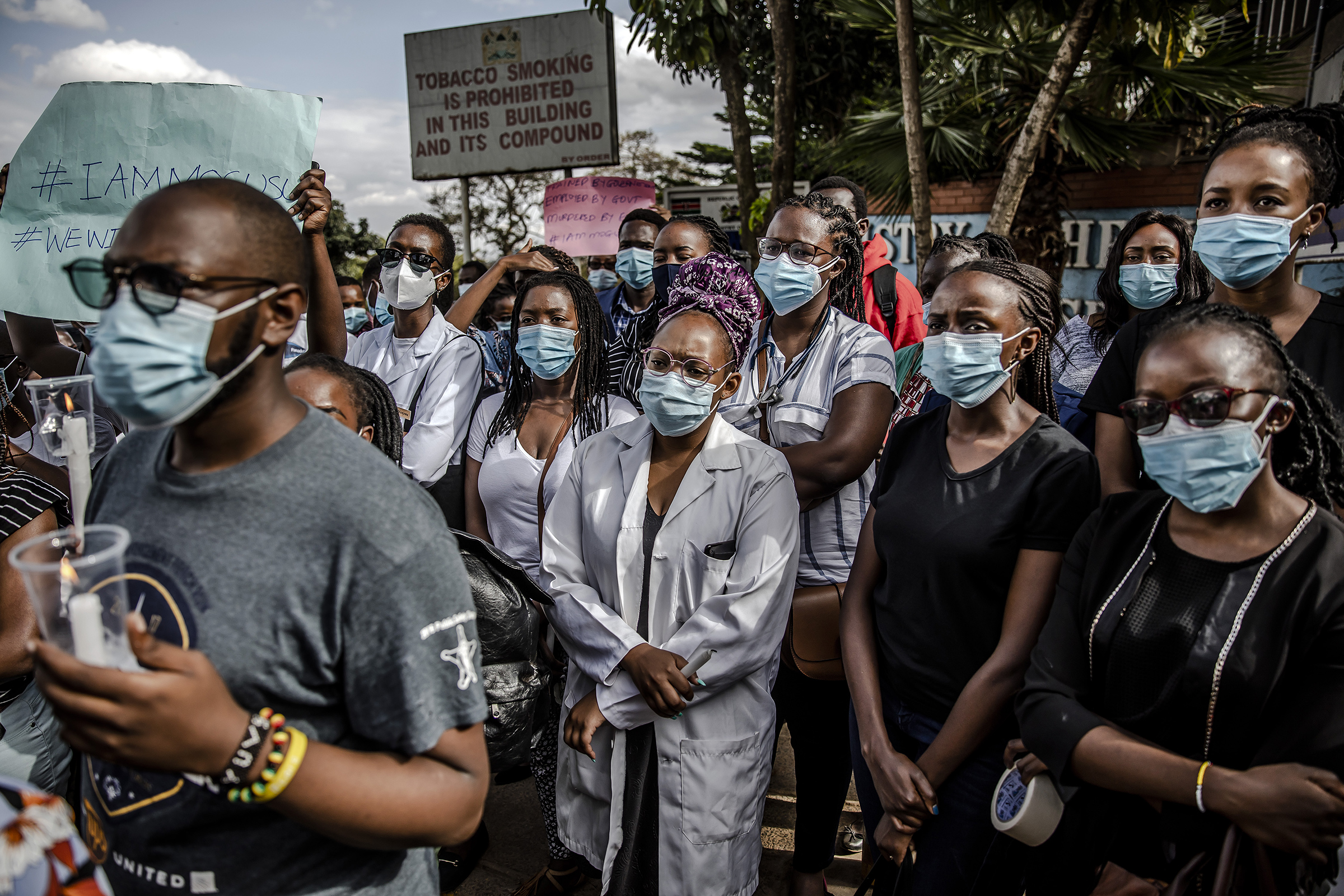
The COVID-19 pandemic, like the climate crisis, is amplifying existing racial and gender injustices in our society. TIME editors Naina Bajekal and Elijah Wolfson moderated a conversation with two women working to create a more inclusive climate leadership space: American author, strategist and teacher Katharine Wilkinson, who co-founded and leads The All We Can Save Project to nurture a leaderful climate community; and queer Colombian activist Maria Alejandra Escalante, who is the climate and environmental justice advocacy officer at FRIDA The Young Feminist Fund, which supports young feminist organizers in the Global South.
We know the pandemic has driven women out of the workforce, including out of academic research, in significant numbers. Do you have a sense of how this is playing out in terms of women’s leadership in the climate space — whether in your own life or from those in your network?
Wilkinson: There’s been a lot of “behind the scenes” conversation among women in climate about how hard the pandemic has been for mothers and caregivers. We’ve heard tales of “dad” colleagues proclaiming with glee how much time they have to write now, and foundation program officers expecting projects to proceed apace—if not faster!. The U.S. is a hard place to be a mother on a good day, in particular given lack of adequate maternity leave or affordable childcare and abundance of unwaged domestic labor, and those good days have been hard to come by in the last year. To be perfectly honest, “thank goodness I don’t have kids” has been a recurring thought for me during the pandemic. For some mothers who work on climate, just a simple good night’s sleep has felt desperately out of reach. Patriarchy, spotlighted by the pandemic, is bad for inclusive climate leadership.
Read More: Meet 15 Women Leading the Fight Against Climate Change
Escalante: In my part of the world, women are connected to climate work from angles of land defense against exploitation, working towards food sovereignty and water protection in their communities. The pandemic has hit their safety and ability to build the equity and redistribution they demand. More rural women than men have lost their jobs and the possibility of other sources of income. Restrictions on mobility, combined with the absence of state presence in remote regions and the liberty gained by extractive corporations, has meant a rising number of women environmental defenders are being physically and digitally surveilled, harassed, and silenced.
In certain countries, the healthcare measures used by governments are excuses to decrease or even violate the rights of rural and Indigenous women and other marginalized identities, like what we have seen in Honduras where sexual and reproductive health rights are even more inaccessible by these communities than before the pandemic hit.
Wilkinson: Most of my work has a U.S. focus, so I really appreciate learning from Maria Alejandra’s insights. During the pandemic, people’s attention has been pulled from climate onto more pressing needs. In 2020 in the U.S., we saw media coverage of climate drop to a whisper even as climate-fueled fires raged. But our attention has also been pulled toward things that are critically important in a warming world—toward people’s precariousness in our extractive economy, toward injustice and interdependence.

Women are more likely to work in the industries impacted by the pandemic, such as leisure, education, social, and health care sectors—70 percent of the health workforce is female; over 70 percent of global caregiving hours are given by women and girls, for example. Presumably climate change will cause similar disparities. Is this an underlying issue that needs to be addressed? How do you think we should address it?
Escalante: The climate crisis is already generating these sorts of disparities. For example, when extended droughts happen, women, especially young women, in rural areas—who are usually the main caretakers of the home—must fetch water from further away, which has implications for their overall wellbeing, safety and time availability for other activities, including self-care and education. In rural and urban communities with weak infrastructure, the disparity is not a prediction of what may happen—it’s a reality.
The pandemic is making it evident that women, young people and gender minorities are at higher risk when systems fail to protect us, given already existing structural inequalities. The health crisis is an angle to observe how a parallel and unfolding emergency—the devastation of our ecological and climate systems—is also hitting these same communities more harshly. Women, young people, gender minorities—especially those who are Black and Indigenous and from the Global South—are at the interconnection of historical systems of oppression and exclusion. We have been marginalized from the centres of decision-making for far too long and that has made invisible our collective experiences.
What is powerful is that, as crises hit, we keep rising. We are building responses and bringing relief to our communities, usually leading from an intersectional place to address both the immediate problem as well as the root causes of their vulnerabilities.
To address these underlying issues we need diverse strategies. A start would be to increase funding to this intersectional organizing. A 2014 report showed that only 0.2% of foundation funding focuses explicitly on women and the environment. To see systemic transformation, we need more unrestricted resources directly placed in the hands of women, young feminists, and gender minorities.
Wilkinson: Maria Alejandra makes so many critical points. I think the pandemic made visible to more people (specifically people of privilege, especially those in the Global North) what is already frayed and fraying in our social and economic systems. As with COVID-19, climate impacts “multiply” existing gender and racial injustices—the cracks already present in our global house, so to speak. It’s a reminder, I think, that social safety nets and social policy more generally are critical climate infrastructure.
Read More: Kenya Is Trying to End Child Marriage. But Climate Change Is Putting More Young Girls at Risk
I’m glad that there’s so much good research being done around the gender-climate nexus, because we need to understand how a warming world is riskier for women and gender minorities than men, riskier still for those who are BIPOC and living in the Global South. And then we need to design interventions and policies that respond to those differences. Otherwise, just as we’ve seen in the pandemic, inequalities deepen and the cracks get wider and more numerous. It’s also why we need to design climate solutions to advance equality and resilience alongside reducing greenhouse gases—what co-founder of Climate Interactive Beth Sawin calls “multisolving.” We can’t do the latter without the former. The Feminist Green New Deal Coalition recently released a helpful policy screening tool that policymakers can use to ensure potential climate legislation has an intersectional gender lens.
It’s worth noting that many of these women-dominant industries are low-carbon industries. We think about “green jobs” as retrofitting buildings or installing wind and solar power—and they are—but care jobs are also green jobs. A care economy is a green economy. So there are climate reasons to strengthen and grow these industries, including ensuring good wages and labor protections.

TIME: Care industries have some of the greatest projected growth and the greatest need for additional workers already. But as industries that have historically been “feminized” they tend to be perceived as less valuable to society, and thus have wages that don’t reflect their value, and fewer labor protections. Do you all think that the pandemic will change this? If not, what is needed to make those changes happen?
Escalante: Your question is on point: can the realizations that the pandemic has brought about structural and gender inequalities be enough to shift these patriarchal and capitalist systems? On one hand, we must reckon with the fact that the pandemic has been approached so differently in every region and sector. In Latin America, for example, the inequalities are only stretching further because of the pandemic, and yet this crisis has been a boom for the tech industry and the wealthiest people of the world. So the lessons that we derive from this health crisis can be so different depending on context.
On the other hand, the pandemic is raising global alarm by showing us that societies and ecosystems are on the verge of collapsing and that doing something drastic, radical, systemic about it is what the moment is calling for. I believe anti-capitalistic work is the disruption we need to re-evaluate the commodification of nature, women and gender non-conforming bodies whose care labor has been historically undervalued. Clearly, politicians are not conceding to this type of disruption, which is why civil society pressure in all decision-making spaces is and will be crucial. Looking at the upcoming U.N. climate negotiations in the U.K., I would expect the political conversations and the media coverage to focus on the type of systemic shifts that are being proposed by the feminist and environmentalist collations around the world—some of which Katharine has also pointed out before.
Wilkinson: During the pandemic, we’ve heard quite a lot about predominantly white, “professional class” women in the US waking up to how dependent their lives have been on domestic workers, teachers, frontline service workers, etc., who are essential but marginalized and largely women of color. As labor activist Ai-jen Poo says of care work, it’s “the work that makes everything else possible.” More privileged individuals seem to be seeing that with fresh eyes.
Read More: Why the Larger Climate Movement Is Finally Embracing the Fight Against Environmental Racism
Will these realizations translate into meaningful change? Will people be politically activated by these realizations or gladly return to pre-pandemic arrangements? I’m not sure. (And the climate crisis certainly reminds us that the gap between knowledge and action can be deep and wide.)
Clearly, we need legal and policy change to secure rights and dignity for all workers, just as we need it to advance just solutions to the climate crisis. We need good, justice-centered research and scholarship to inform it. We need those who are on the frontlines (of the pandemic, climate injustice, often both) to be centered in decision-making, not absent from the halls of power. As Maria Alejandra said, civil society has a vital role to play there. And we need the cultural shifts that make political change possible. I think there are some hopeful signs that those cultural shifts are accelerating—stories changing, hearts changing—but there is just so much work ahead.
I also think it’s worth noting that the material and psychological toll of the pandemic—the isolation, the stress—means lots of folks aren’t showing up for the work of transformational change, which is what science tells us is required this decade, with their full superpowers. Not by a long shot. It strikes me as a presage of the challenges we’ll increasingly face to survive the climate crisis while we work to solve it.
Given the climate trajectory we’re on, there are hard things ahead—surely harder than the concurrent crises of 2020, which seemed unprecedented to many. I hope we’ll heed its lessons and find ways forward that don’t replicate injustices but redeem them. The success of mutual aid efforts over the last year is a reminder, I think, that in a liminal time like the one we’re in, we must link arms. Or as Christine Nieves Rodriguez, a Puerto Rican climate leader, says in her essay in All We Can Save, “community is our best chance for survival.”
TIME: Given that our collective attention and energy is majorly sapped, where should we direct what energy remains?
Wilkinson: We’ve been thinking about this a lot in the context of The All We Can Save Project. To me, the bottom line is that the climate crisis is a leadership crisis. Today, far too many leaders across sectors continue to prioritize profit (including some who say they don’t), while so many people who genuinely care are still standing on the sidelines. A growing body of research shows that women’s leadership and equal participation result in better outcomes for climate policy, reducing emissions, and protecting land, but white men continue to hold most of the power and get most of the funding and airtime.
If we want to grow a life-giving future, we need an abundantly leaderful climate movement. I think we should center and support and follow the work and wisdom of women, especially women of color, leading at the grassroots/on the frontlines, in elected office working to change policy, in media and communication working to shift culture, and beyond. Just like there are no silver bullet climate solutions—a whole ecosystem of practices and technologies is necessary to stop emissions and drawdown carbon—there is no single sector of leadership that will get the job done. I wish there were. Let’s welcome in and grow the biggest, strongest team possible. I really believe that’s our best chance.
Escalante: We need a mix of creativity, strategy, vision and action. It is indeed a reality for many women-led movements and communities, particularly in Global South regions, that this health crisis has centred the question of immediate relief and shadowed other “less visible” threats around the corner for rich countries, like the climate one. The burdens of the pandemic are huge for those who already live in precarious conditions and under multiple vulnerabilities, like the hundreds of migrant people all across the world enduring severe drought, floods, economic encroachment, and forced migration and having to deal with closed borders and anti-migrant governments.
Yet, it is amidst uncertainty and fear, that these movements and communities are showing generosity and emergent strategies to adapt to these compounded crises. Eldoret Women For Development——a FRIDA’s young feminist grantee partner—is fighting for the rights of incarcerated women in the Eldoret slums of Kenya. The pandemic caused women’s prisons to move toward decongestion as a way of limiting the spread of the virus; more than 100 of these incarcerated women are now a part of the Eldoret Women agribusiness program that grants them both a means of earning, as well as the opportunity for sustainable living. This community of women, which includes trans women and sex workers, are growing organic food in their own homes, using innovative methods, during the lockdown. To me, this speaks to the capacities that all of these communities have when it comes to shifting from chaos to solutions in times of crisis.
Energies need not be channeled in only one direction. I believe that it is these social and inclusive movements in different regions, particularly youth and women-led ones, that are rising up to the challenge of inadequate health systems, economic precarity, food insecurity, and gender-based violence with real alternatives at hand and with very little resources, even during a pandemic. If resources—financial, human, media, etc—are directed to these movements that understand their community’s needs, with a long-term vision of support, this would allow them to focus on transforming our world, rather than chasing every coin, worried about their survival.
So, as Katharine was pointing out, I see the need to fund and bolster justice in every instance. As we do that, we should center the knowledge, voices, experiences of those who have not participated in shaping this faulty world. This includes radical political leaders speaking up to power and building policies on justice-grassroots-based visions. This also includes a demand for equal rights for all people across sectors. This is not an unachievable future if there is a real commitment from governments, institutions, donors, academia and media. The pandemic has shown us that we can adapt and prioritize when needed and urgent. If we don’t do this now for the climate crisis, then when?
More Must-Reads From TIME
- Dua Lipa Manifested All of This
- Exclusive: Google Workers Revolt Over $1.2 Billion Contract With Israel
- Stop Looking for Your Forever Home
- The Sympathizer Counters 50 Years of Hollywood Vietnam War Narratives
- The Bliss of Seeing the Eclipse From Cleveland
- Hormonal Birth Control Doesn’t Deserve Its Bad Reputation
- The Best TV Shows to Watch on Peacock
- Want Weekly Recs on What to Watch, Read, and More? Sign Up for Worth Your Time
Write to Naina Bajekal at naina.bajekal@time.com